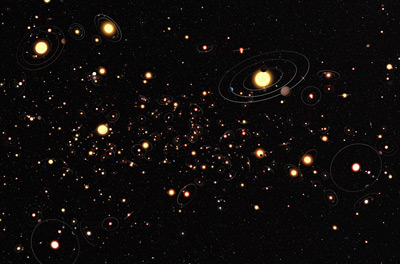
Our Milky Way galaxy contains a minimum of 100 billion planets according to a detailed statistical study based on the detection of three extrasolar planets by an observational technique called microlensing.
Kailash Sahu, of the Space Telescope Science Institute in Baltimore, Md., is part of an international team reporting today that our galaxy contains a minimum of one planet for every star on average. This means that there is likely to be a minimum of 1,500 planets within just 50 light-years of Earth.
The results are based on observations taken over six years by the PLANET (Probing Lensing Anomalies NETwork) collaboration, which Sahu co-founded in 1995. The study concludes that there are far more Earth-sized planets than bloated Jupiter-sized worlds. This is based on calibrating a planetary mass function that shows the number of planets increases for lower mass worlds. A rough estimate from this survey would point to the existence of more than 10 billion terrestrial planets across our galaxy.
The results are being published in the January 12 issue of the British science journal Nature.
The team's conclusions are gleaned from a planet search technique called microlensing. The technique takes advantage of the random motions of stars, which are generally too small to be noticed. If one star passes precisely in front of another star, the gravity of the foreground star bends the light from the background star.
This means that the foreground star acts like a giant lens amplifying the light from the background star. A planetary companion around the foreground star can produce additional brightening of the background star. This additional brightening reveals the planet, which is otherwise too faint to be seen by telescopes.
See the website for more details : http://hubblesite.org/newscenter/archive/releases/2012/07/full/ (SY)
